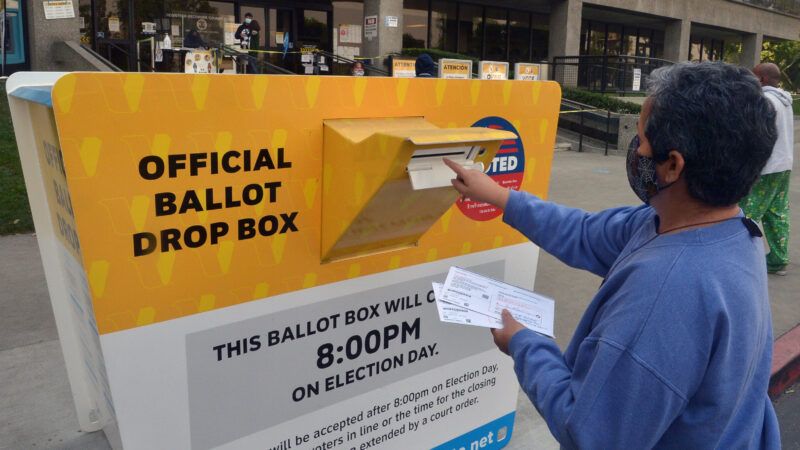California Voters Might Have a Chance To Ban Government Unions in 2022
One of two ballot measures already proposed for 2022 in California takes on some of the most powerful special interests in state politics.

In the heat of the recall election, California progressives were hyperventilating over the supposed awfulness of a direct-democratic process that has been embedded in our state's constitution since the early 1900s. That's when Gov. Hiram Johnson introduced the recall, referendum, and initiative to give the people a chance to thwart special interests.
It's always dangerous to make drastic long-term changes in response to short-term political frustrations. As it turned out, Gov. Gavin Newsom survived the recall vote by an overwhelming margin. The system worked as intended. Just because a measure qualified for the ballot didn't mean that a majority of voters would necessarily approve it.
Fortunately, Newsom acted sensibly in the wake of his victory. He last week vetoed legislation by Sen. Josh Newman (D–Anaheim), who was recalled from office in 2018 and still wants to change the rules. Senate Bill 660 would have banned campaigns (for recalls, initiatives, and referenda) from paying signature-gatherers on a per-signature basis.
Newsom correctly noted that the bill would "make the qualification of many initiatives cost-prohibitive for all but the wealthiest interests, thereby having the opposite effect." It would have damaged our direct democracy, which—despite its flaws—remains the best check on our government overseers.
We also learned last week of two new ballot measures for the 2022 ballot that embody the spirit of Gov. Johnson. They're certainly longshots—but one of the most compelling aspects of the initiative process is that it enables governmental outsiders to force out-of-the-box ideas onto the agenda. It is unquestionably a costly process to collect enough signatures to place measures on the ballot and win a majority of voters.
In this process, however, Californians can debate ideas that legislators have ignored. The first proposal would ban collective bargaining for government workers. The second measure would require 2 percent of the state's general-fund revenue each year to fund water projects until the state amasses an additional 5 million acre-feet of available water supplies.
"After the Legislature authorized collective bargaining by public employee unions, public employment costs have exploded, including taxpayer-funded pensions and lifetime health benefits not enjoyed by employees in the private sector," explained the union-related initiative's official statement.
That's an accurate description, based on extensive news coverage and audits of public schools, law enforcement agencies, and the state's administrative agencies. Public-sector unions usually are the single biggest obstacle to even the most modest reforms to improve public services given their vested interest in preserving the status quo.
The teachers' unions try to undermine educational alternatives such as charter schools and defend tenure and other employee protections that make it impossible to fire bad teachers or to reward the good ones. Police unions accomplish the same task for their members. The disturbing impact on the quality of the state's public services is immeasurable.
Billionaire venture capitalist Tim Draper from Silicon Valley is its proponent. "If you go back to 1976, the unions were not involved in the negotiations, and the outcomes were excellent. California was Number 1 in K-12 education and Number 1 as a place to do business," he told me, via email. "Now, since the unions have been involved, California has dropped to Number 47 in education and dead last…as a place to do business."
He's right, but it's going to be tough to take on all of the state's major unions at once. Draper was the proponent of a 2014 initiative that would have broken California into six states. That never got legs, but it was a cool thought experiment. If nothing else, it got Californians talking about the way that our current politics, which concentrates power in two mega-metropolitan areas, shortchange the state's less-populated regions.
The water initiative is sure to be less controversial than Draper's idea given that the drought is a top concern among voters. It already is building support. For instance, the Orange County Water District's board of directors voted 8-2 last week to support it. It even has Democratic legislative backers.
California has built little water infrastructure since the 1970s, when our population was roughly half its current size. It's better to fund such projects through revenue bonds rather than general-fund expenditures, but that's, well, water under the bridge. We need to do something to assure an adequate amount of future water supplies—rather than resign ourselves to rationing.
Right on cue, the Sierra Club blasted the initiative by telling the OCWD that it would better "funnel its resources towards increasing conservation, storm-water capture…repairing leaks and replacing old pipes" and other green projects. Yet those types of projects—they're fine, but none would appreciably increase supply—could easily grab funding under the initiative's guidelines.
A robust initiative process doesn't guarantee the state will rein in the power of public-sector unions or build up its water infrastructure, but at least the decision ultimately will be made by the people.
This column was first published in The Orange County Register.


Show Comments (41)